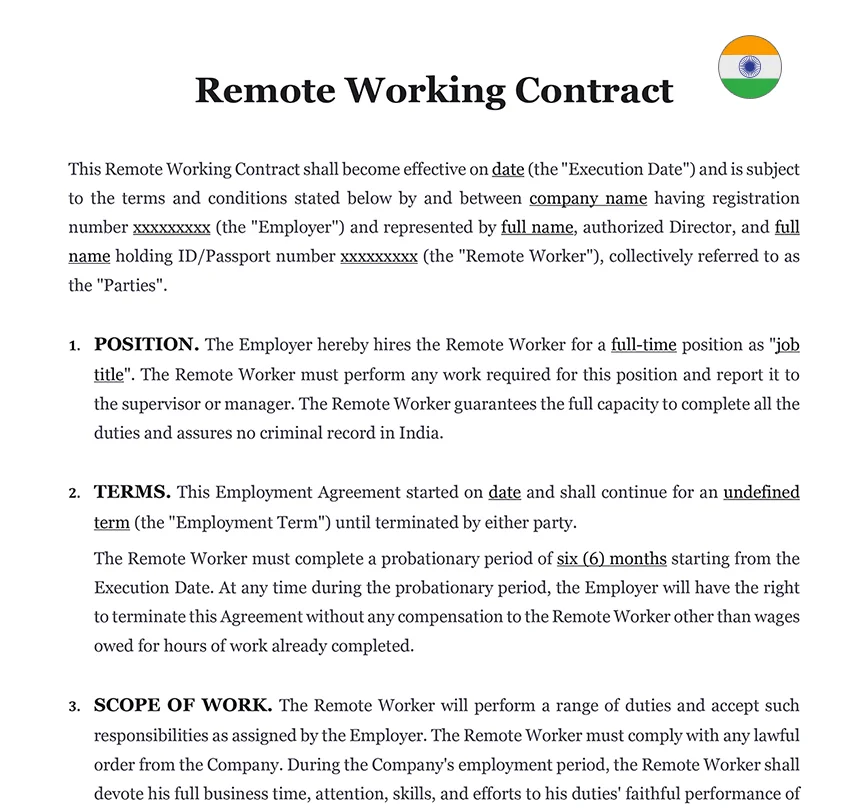Ready to use legal template
Drafted by experienced lawyers
Compliant with Indian law
Ready to use legal template
Drafted by lawyers
Compliant with Indian law
Learn more about Remote Working Contract in India
A remote working contract is a legal agreement between an employer and an employee who will be working remotely. It outlines the terms and conditions of the remote work arrangement, including job responsibilities, working hours, communication methods, equipment provision, data security, and termination conditions. It ensures clarity and sets expectations for both parties involved in the remote work arrangement.
Table of contents
What is a Remote Working Contract
A remote working contract, also known as a telecommuting or remote employment agreement, is a legal document that outlines the terms and conditions between an employer and an employee who will be working remotely. This type of contract is specifically designed for individuals who perform their job duties outside of a traditional office setting, often from their own homes or other remote locations.
Why use a Remote Working Contract ?
Using a remote working contract is important for several reasons:
Clarity and expectations: A remote working contract clearly defines the terms and conditions of the remote work arrangement, ensuring that both the employer and employee have a clear understanding of their roles, responsibilities, and expectations.
Legal protection: A well-drafted contract protects the rights and interests of both parties involved. It helps prevent potential disputes by clearly outlining the rights, obligations, and liabilities of each party.
Compliance: The contract ensures compliance with applicable labor laws and regulations, as well as any specific legal requirements related to remote work, such as data protection and privacy laws.
Confidentiality and data security: A remote working contract can include provisions that address data security, confidentiality, and intellectual property protection. This helps safeguard sensitive information and trade secrets of the employer.
Performance management: The contract can outline performance evaluation mechanisms, deadlines, and productivity expectations. It provides a framework for assessing and managing the remote employee’s performance.
Equipment and expenses: A remote working contract can specify the equipment and tools provided by the employer and address reimbursement for expenses related to remote work, such as internet costs or phone bills.
Termination conditions: The contract can define the conditions and procedures for terminating the remote work arrangement, protecting the rights of both the employer and employee.
What should a Remote Working Contract include?
A remote working contract should include the following key elements:
1. Parties involved: Clearly state the names and contact information of the employer and the remote employee.
2. Employment details: Specify the nature of the employment relationship, such as full-time, part-time, independent contractor, or temporary worker.
3. Job responsibilities: Outline the specific duties and responsibilities of the remote employee, including any project deadlines or performance expectations.
4. Working hours: Define the working hours of the remote employee, whether they are fixed or flexible, and address any considerations for overtime, breaks, or time tracking.
5. Communication and collaboration: Specify the preferred methods of communication between the remote employee and the employer, such as email, video conferencing, or project management tools. Address expectations for availability and responsiveness.
6. Equipment and expenses: Clarify the equipment and software provided by the employer, such as laptops, smartphones, or other necessary tools for remote work. Address any reimbursement policies for internet access, phone bills, or other related expenses.
7. Data security and confidentiality: Include provisions to protect the confidentiality of information and data security measures. Address any intellectual property rights or non-disclosure agreements that may apply.
8. Performance evaluation: Outline the mechanisms for performance evaluation, feedback, and assessment of the remote employee’s work. Specify any performance metrics or evaluation criteria that will be used.
9. Termination conditions: Define the conditions under which the remote work arrangement can be terminated by either party. Address notice periods, severance, or any other relevant termination procedures.
10. Applicable laws and jurisdiction: Specify the governing law and the jurisdiction in which any legal disputes will be resolved.
How does it offer legal protections?
A remote working contract offers legal protections by clearly establishing the rights, obligations, and responsibilities of both the employer and the remote employee. It provides a written agreement that can be referred to in case of any disputes or disagreements. Here’s how it offers legal protections:
Clarity of terms: The contract clearly outlines the terms and conditions of the remote work arrangement, including job responsibilities, working hours, communication methods, and equipment provision. This clarity helps prevent misunderstandings and misinterpretations, reducing the likelihood of disputes.
Compliance with laws: The contract ensures compliance with applicable labor laws and regulations. It helps both parties understand and adhere to legal requirements related to employment, remote work, data protection, confidentiality, and any other relevant laws or regulations.
Dispute resolution: In case of a dispute or disagreement, the contract serves as a reference point for resolving the issue. It provides a clear framework for addressing conflicts, including provisions for mediation, arbitration, or legal procedures if necessary.
Protection of rights and obligations: The contract outlines the rights and obligations of both the employer and the remote employee. It protects the rights of the employee, such as fair compensation, benefits, and working conditions. It also ensures that the employer’s interests, such as confidentiality of information and intellectual property rights, are safeguarded.
Termination conditions: The contract specifies the conditions and procedures for terminating the remote work arrangement, protecting the rights of both parties involved. It addresses notice periods, severance, and any other relevant termination provisions, helping to minimize the risk of wrongful termination claims.
Confidentiality and data security: The contract can include provisions related to data security, confidentiality, and intellectual property protection. It helps protect the employer’s sensitive information, trade secrets, and intellectual property rights.
What if I don’t have a Remote Working Contract ?
If you don’t have a remote working contract, it can create several potential issues and uncertainties for both the employer and the remote employee. Here are some key implications:
1. Ambiguity in terms and conditions: Without a remote working contract, there may be ambiguity or misunderstandings regarding job responsibilities, working hours, communication methods, equipment provision, and other important aspects of the remote work arrangement. This can lead to conflicts and disputes.
2. Lack of legal protection: A contract serves as a legal document that protects the rights and interests of both parties. Without a contract, there may be a lack of legal protection for the employer and the remote employee in case of disputes, terminations, or breaches of agreement.
3. Unclear expectations: A remote working contract sets clear expectations for both parties, ensuring that they understand their respective roles, obligations, and performance expectations. Without a contract, it may be challenging to manage and evaluate the remote employee’s performance effectively.
4. Compliance issues: A contract helps ensure compliance with applicable labor laws, regulations, and other legal requirements. Without a contract, there may be a higher risk of non-compliance with employment laws, data protection regulations, and other legal obligations.
5. Lack of confidentiality and data security measures: A contract can include provisions related to data security, confidentiality, and intellectual property protection. Without such provisions, there may be an increased risk of unauthorized disclosure of sensitive information and inadequate protection of intellectual property.
6. Difficulty in dispute resolution: In the absence of a contract, resolving disputes or disagreements may become more challenging and time-consuming. Parties may not have a clear framework to refer to, which could lead to protracted conflicts or legal disputes.
How does it mitigate risks and challenges?
A remote working contract helps mitigate risks and challenges in several ways:
1. Clear expectations: The contract establishes clear expectations regarding job responsibilities, working hours, communication methods, and performance expectations. This clarity reduces the risk of misunderstandings and ensures that both parties have a shared understanding of their roles and obligations.
2. Legal protection: The contract serves as a legally binding agreement that protects the rights and interests of both the employer and the remote employee. It provides a framework for resolving disputes, addressing breaches of agreement, and ensuring compliance with applicable laws and regulations.
3. Confidentiality and data security: The contract can include provisions related to data security, confidentiality, and intellectual property protection. By clearly defining expectations and responsibilities regarding data protection and confidentiality, the contract helps mitigate the risk of unauthorized disclosure and ensures the employer’s sensitive information and intellectual property are adequately safeguarded.
4. Termination conditions: The contract specifies the conditions and procedures for terminating the remote work arrangement. This reduces the risk of wrongful termination claims and provides clarity on notice periods, severance, and any other relevant termination provisions.
5. Performance management: The contract can include provisions for performance evaluation, feedback mechanisms, and performance improvement plans. This helps ensure that the remote employee’s performance is effectively managed, monitored, and evaluated, reducing the risk of performance-related challenges.
6. Dispute resolution: The contract can outline procedures for dispute resolution, such as mediation or arbitration. Having a predetermined process for resolving disputes reduces the likelihood of protracted conflicts and legal disputes, saving time, effort, and potential costs for both parties.
7. Compliance with legal requirements: The contract helps ensure compliance with employment laws, data protection regulations, and other relevant legal requirements. By clearly stating the rights and obligations of both parties, the contract helps minimize the risk of non-compliance and potential legal repercussions.
Overall, a remote working contract provides structure, clarity, and legal protection for both the employer and the remote employee. It establishes a solid foundation for the remote work arrangement, mitigating risks, and addressing challenges that may arise during the course of the employment relationship.
SPECIAL OFFER
HR Pro
15 Document Package
Essential documents for managing employees in India
Remote Working ContractTemplate (.docx)
Save on attorney fees
310 client reviews (4.8/5) ⭐⭐⭐⭐⭐
Share information
Why Themis Partner ?
Make documents forhundreds of purposes
Hundreds of documents
Instant access to our entire library of documents for India.
24/7 legal support
Free legal advice from our network of qualified lawyers.
Easily customized
Editable Word documents, unlimited revisions and copies.
Legal and Reliable
Documents written by lawyers that you can use with confidence.




